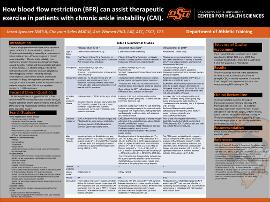| dc.contributor.author | Spencer, Jared | |
| dc.contributor.author | Sales, Cheyann | |
| dc.contributor.author | Warren, Aric | |
| dc.date.accessioned | 2023-11-02T20:44:10Z | |
| dc.date.available | 2023-11-02T20:44:10Z | |
| dc.date.issued | 2023-02-17 | |
| dc.identifier | ouhd_Spencer_ howbloodflowrestriction_2023 | |
| dc.identifier.citation | Spencer, J., Sales, C., and Warren, A. (2023, February 17). How blood flow restriction (BFR) can assist therapeutic exercise in patients with chronic ankle instability (CAI). Poster presented at Research Week, Oklahoma State University Center for Health Sciences, Tulsa, Ok. | |
| dc.identifier.uri | https://hdl.handle.net/11244/339881 | |
| dc.description.abstract | Clinical scenario: The high recurrence of lateral ankle sprains progresses to chronic ankle instability and can affect many athletes in all sports. Chronic ankle instability (CAI) is often associated with a decrease in muscle strength, increase in pain, decrease in range of motion, and decrease in balance or neuromuscular control. The use of blood flow restriction with CAI can increase muscular outcomes and be used as a rehabilitation tool. | |
| dc.description.abstract | Clinical Question: Is there evidence to suggest that blood flow restriction improves strength, muscle activation and (or) cross-sectional area (CSA) of the lower leg musculature in those with chronic ankle instability? | |
| dc.description.abstract | Summary of Key Findings: The three studies evaluated one of the muscular outcomes of either strength, CSA, or muscle activation in result of BFR training. Each of the three studies reported a type of significant improvement in muscular outcomes using BFR for CAI. | |
| dc.description.abstract | Clinical Bottom line: There is moderate evidence to support therapeutic exercise with low-intensity blood flow restriction in patients with chronic ankle instability. The evidence concluded a significant improvement in BFR to increase muscle activation of fibularis longus, anterior tibialis, vastus lateralis, and soleus.1-2 There is moderate evidence suggesting BFR can induce strength gains in the muscles dependent on the exercise selection. | |
| dc.description.abstract | Recommendation: Grade B exists for the use of blood flow restriction with therapeutic exercise for patients with CAI. Further research in exercise selection and regimen can change confidence in efficacy. | |
| dc.format | application/pdf | |
| dc.language | en_US | |
| dc.publisher | Oklahoma State University Center for Health Sciences | |
| dc.rights | The author(s) retain the copyright or have the right to deposit the item giving the Oklahoma State University Library a limited, non-exclusive right to share this material in its institutional repository. Contact Digital Resources and Discovery Services at lib-dls@okstate.edu or 405-744-9161 for the permission policy on the use, reproduction or distribution of this material. | |
| dc.title | How blood flow restriction (BFR) can assist therapeutic exercise in patients with chronic ankle instability (CAI) | |
| osu.filename | ouhd_Spencer_ howbloodflowrestriction_2023.pdf | |
| dc.type.genre | Presentation | |
| dc.type.material | Text | |
| dc.subject.keywords | blood flow restriction | |
| dc.subject.keywords | BFR | |
| dc.subject.keywords | chronic ankle instability | |
| dc.subject.keywords | CAI | |
| dc.subject.keywords | blood flow restriction and therapeutic exercise | |
| dc.subject.keywords | ankle sprain | |
| dc.subject.keywords | therapeutic exercise | |
